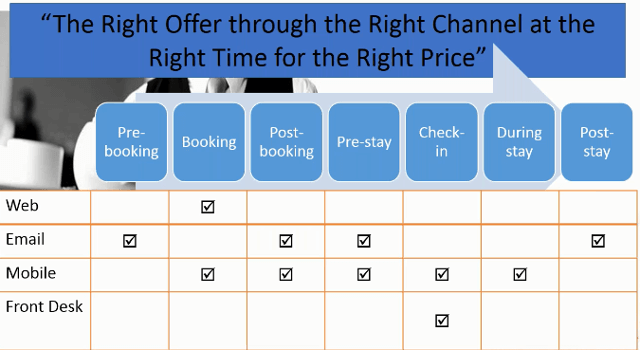
As technology constantly evolves, so does revenue management (RM). Dan Skodol, VP of Revenue Analytics at Rainmaker, recently gave a presentation on the top trends in revenue management. The trends he discussed were loyalty based pricing by the major chains, the impact of alternative accommodations, advances in group revenue management, opportunities for focusing on ancillary revenues, and personalization as a key to driving bookings.
NB: This is an article by Rainmaker
These trends crystallized after a few years of looking at common themes that emerged from attending industry conferences, many discussions with Rainmaker’s customers, and conversations with industry experts. In this post we will touch on the topics of loyalty-based pricing and advances in group revenue management.
Loyalty-Based Pricing by Major Chains
One of the primary purposes of loyalty-based pricing is to shift bookings away from OTAs and encourage direct bookings. Brands have launched initiatives to offer special discounts and offers for loyalty program members. A recent study done by Kalibri labs indicates these programs are working for the companies that have launched them. Truly loyal customers will be willing to book directly through a brand’s website when offered targeted, personalized offers.
Hotel brands benefit from this by avoiding OTA commissions and having direct access to the guest. In most cases, this means the property will earn more on that booking, but it requires a thorough understanding of direct booking costs. You’ll want to compare OTA fees against your brand fees, marketing costs for the loyalty program, and the net dilution amount to truly understand whether the loyalty program is a profitable option for your property. The dynamics can be tricky: brands are ultimately benefitting from the loyalty effect but the transactional value for hotels, considering the brand fees and all your revenues net of all the costs associated, might not differ across these channels.
The cost/benefit comparisons of loyalty program discounts are never simple, because there are multiple channel options depending on the guest segment in question. For instance, negotiated corporate rates could be a better value for your customers and lead to more group bookings, but may require fees from a corporate travel agency. You’ll want to optimize your overall channel mix and understand the corresponding distribution costs at a very granular level.
Advances in Group Revenue Management
Despite overall hotel RevPAR growth, group-based revenue has lagged in recent years. The science of revenue management has traditionally been focused on managing transient demand whereas group pricing has typically been less scientific. This has prompted recent technological advances in the field of group RM, and tools have emerged that help optimize group pricing decisions. These new systems help, in part, by streamlining the sales cycle for hotels and sales teams.
The latest advances include price optimization models, group forecasting algorithms, lead scoring mechanisms, tools that manage function space, as well as tools to administer catering free sell rules. If your hotel has a high or growing amount of group business, you’ll want to stay in tune with the rapidly developing technology in this field.
Opportunities for Focusing on Ancillary Revenues
There’s a huge opportunity for profits when hotels focus on their guests’ ancillary spending as a way to grow revenue. A report done by Eye for Travel estimated total ancillary revenues worldwide at $80-130B. In a survey conducted among general managers, 57% planned to increase their investment into ancillaries in the next 12 months, and 23% of general managers said their RMS does not account for any ancillary spending, while another 20% indicated they do not have an RMS at their property.
In a survey conducted among hotel guests, 60% said they would purchase add-ons during their stay, but 40% said they still needed to be convinced. For guests that wouldn’t purchase add-ons, 58% felt that the property is simply trying to make more money off them, and 63% felt that the products or services offered were not relevant to them.
The opportunities to expand profitability with ancillary revenues can happen at any type of property, from a roadside inn to a casino or mega-resort. You’ll need to use your RMS to assess your ancillary opportunities and then determine how to maximize their potential. You’ll also want to examine your data needs and collection methods, whether you capture data solely via folio charges or if you have other means of capturing ancillary spend data. You could even provide an incentive for guests to help you with the effort of collecting ancillary spend data, like an F&B credit for filling out a survey. Finally, use the data and customer feedback that you receive to better understand your customer and their needs.
Personalization as a Key to Driving Direct Bookings
Hotels have an opportunity to shift bookings away from 3rd party channels to direct channels by offering their guests a more personalized experience. You can achieve similar booking volume results at a potentially higher price by understanding and anticipating guest needs. Personalization can start in the booking experience and last throughout the guest’s entire stay, even past checkout.
It’s important to note that this doesn’t necessarily require a customer database with preferences or specific data on what your customers did on previous stays. Likewise, it does not depend on your customers being repeat guests. There are approaches where you can predict a customer’s needs or what they are likely to purchase based on some of the characteristics or attributes of their stay. For example, things you might be able to glean from a single guest making a one-night midweek stay versus three guests in a room staying three nights including a weekend.

Data from customer behavior should be used to drive revenue decisions and actions. Be sure to adopt a consistent strategy around collecting the right data. Consider your customer touch-points, where you have the opportunities to make a personalized sale to a customer beyond the point of booking. The graphic above illustrates touch points where you can identify the optimal time and place to communicate with customers and offer them something more personal that results in additional purchases.




